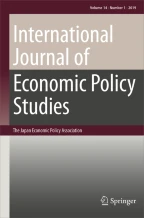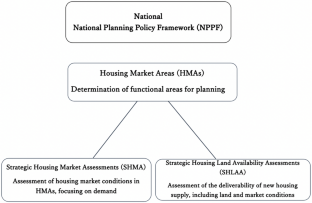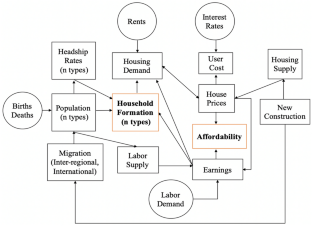An analysis of strategic housing market assessment as an evidence for the UK local housing planning

Local planning authorities in the UK are facing serious challenges regarding housing supply. Under such background, Strategic Housing Market Assessment (SHMA) was introduced to provide the main evidence for local housing planning and policy, by objectively accessing local housing need, especially affordable housing need. Local planning authorities are supposed to conduct SHMAs regularly to ensure that housing policy is based on objectively assessed needs. However, previous studies have shown that key questions remain about SHMAs’ effectiveness. Meanwhile, the last two decade has seen great progress in Evidence-based Policymaking (EBPM). Since SHMAs provide the main evidence for local housing policy, it is necessary to evaluate how robust the current SHMAs are. This research explores the methodological robustness of SHMAs, namely the transparency and adequacy of the method and data used to assess housing need, by reviewing the most up-to-date SHMAs and making comparisons with previous versions. As results, we have three findings. First, opacities remain surrounding the research methods and data sources. Second, regarding the specific way of assessing housing need, most SHMAs assess current housing need based on housing register data and future housing need based on household projection data. Third, the methodological weaknesses pointed out by previous studies are no longer common in the current SHMAs. However, there are still concerns regarding forecasting future housing need based on household projection, since housing is a market-based system driven by interactions of many economic and social factors.
This is a preview of subscription content, log in via an institution to check access.
Access this article
Subscribe and save
Springer+ Basic
€32.70 /Month
- Get 10 units per month
- Download Article/Chapter or eBook
- 1 Unit = 1 Article or 1 Chapter
- Cancel anytime
Buy Now
Price includes VAT (France)
Instant access to the full article PDF.
Rent this article via DeepDyve


Similar content being viewed by others

Planning, Housing Supply and Affordable Provision in Britain
Chapter © 2017

Appraisal of Housing Finance in Pakistan for Low-Income Groups: Concepts and Processes
Chapter © 2022

Developing Regional and Local Housing Strategies
Chapter © 2017
Notes
Knowledge broker organization is an intermediary organization that develop the relationships between the producers and users of knowledge, such as research, and facilitate users’ access to different types of knowledge. As representative examples, What Works Centers are working on ensuring that the best available evidence on ‘what works’ is available to policymakers.
Headship rates measure the proportion of individuals in the population, in a particular age/sex/marital status group, who head a household. Projected headship rates are applied to projected populations to produce projected numbers of households (DCLG [10], p.37).
The six local authorities are Brighton and Hove, Castle Morpeth, Macclesfield, Yorkshire and Humberside, Peak Sub-Region, North West Region.
A concealed household is a household that currently lives within another household but has a preference to live independently and is unable to afford appropriate market housing (DCLG [10], Annexes p.37).
References
- DCLG. (2017a). Government Housing White Paper. Fixing our broken housing market. https://www.gov.uk/government/uploads/system/uploads/attachment_data/file/590464/Fixing_our_broken_housing_market_-_print_ready_version.pdf.
- DCLG. (2017b). Planning for the right homes in the right places: consultation proposals. https://www.gov.uk/government/consultations/planning-for-the-right-homes-in-the-right-places-consultation-proposals.
- ECOTEC Research and Consulting. (2009). The methods, findings and impact of strategic housing market assessments in the South West. Taunton, South West Councils. https://vdocuments.mx//the-methods-findings-and-impact-of-strategic-housing-a-media-a-swhb-a.
- Ferrari, E., Laughlin, D. L., & Watkins, C. (2011). Planning and the housing market: Reflections on strategic housing market assessment in England. Town Planning Review,82(4), 393–423. https://doi.org/10.3828/tpr.2011.24. ArticleGoogle Scholar
- DCLG. (2011). Planning Policy Statement 3(PPS3): Housing, 4th edn. https://www.housinglin.org.uk/_assets/Resources/Housing/Policy_documents/PPS3.pdf.
- Cabinet Office of the UK. (2010). The Coalition: Our programme for Government. https://assets.publishing.service.gov.uk/government/uploads/system/uploads/attachment_data/file/78977/coalition_programme_for_government.pdf.
- DCLG. (2012). National Planning Policy Framework (NPPF). https://webarchive.nationalarchives.gov.uk/20180608095821/https://www.gov.uk/government/publications/national-planning-policy-framework--2.
- Ferrari, E. (2008). Do planners need to understand housing markets? In ACSP/AESOP Conference, Chicago, June.
- Hincks, S., & Baker, M. (2013). Housing market areas and the strategic planning of housing in England. Town Planning Review,84(1), 127–152. https://doi.org/10.3828/tpr.2013.7ArticleGoogle Scholar
- DCLG. (2007). SHMA Practice Guidance 2007 Version 2 and Annexes, Annex G P37. https://assets.publishing.service.gov.uk/government/uploads/system/uploads/attachment_data/file/11813/Strategic_Housing_Market_Assessments-_Annexes.pdf
- DCLG. (2020). Planning Practice Guidance (PPG): Housing and economic development needs assessment. Published on 20 March 2015 and last updated on 12 December 2020. https://www.gov.uk/guidance/housing-and-economic-development-needs-assessments
- ODPM (Office of the Deputy Prime Minister), Andrew, M., Allmendinger, P., Ball, M., Cameron, G., Evans, A., Gibb, K., Goody, J., Holmans, A., Kasparova, D., Meen, G., Monk, S., Muellbauer, J., Murphy, A., Whitehead, C., & Wilson, A. (2005). Affordability targets: Implications for Housing Supply.
- Bramley, G., & Watkins, D. (2016). Housebuilding, demographic change and affordability as outcomes of local planning decisions: Exploring interactions using a sub-regional model of housing markets in England. Progress in Planning,104, 135. https://doi.org/10.1016/j.progress.2014.10.002ArticleGoogle Scholar
- Meen, G., & Andrew, M. (2008). Planning for housing in the post-Barker era: Affordability, household formation, and tenure choice. Oxford Review of Economic Policy,24(1), 79–98. https://doi.org/10.1093/oxrep/grn010ArticleGoogle Scholar
- Barker, K. (2004). Review of Housing Supply: Delivering stability – Securing Our Future Needs, Final Report – Recommendations. London: HM Treasury.
- Barker, K. (2008). Planning policy, planning practice, and housing supply. Oxford Review of Economic Policy,24(1), 34–49. https://doi.org/10.1093/oxrep/grn001ArticleGoogle Scholar
- Cole, I. (2007). Understanding and Responding to Housing Market Change. York, Joseph Rowntree Foundation. https://www.jrf.org.uk/sites/default/files/jrf/migrated/files/2064.pdf
- Bramley, G., Pawson, H., White, M., Watkins, D., & Pleace, N. (2010). Estimating Housing Need. Communities and Local Government, London. https://eprints.whiterose.ac.uk/72850/1/estimatinghousingneed.pdf
- Smith, L. (2017). Planning for housing. House of commons library. https://researchbriefings.parliament.uk/ResearchBriefing/Summary/SN03741
- Greater Manchester Combined Authority Research Team. (2019). Greater Manchester Strategic Housing Market Assessment. https://www.greatermanchester-ca.gov.uk/media/1733/gm-shma-jan-19.pdf
- Tribal. (2010). Tyne and Wear Strategic Housing Market Assessment. Tyne and Wear County Council. https://www.stroud.gov.uk/environment/planning-and-building-control/planning-strategy/evidence-base/housing-evidence/gloucestershire-strategic-housing-market-assessment-shma
- The University of Sheffield. (2013). Sheffield Strategic Housing Market Assessment. Sheffield City Council. https://www.sheffield.gov.uk/home/housing/strategic-housing-market-assessment.html
- The University of Sheffield. (2014). Rotherham Strategic Housing Market Assessment. Rotherham Metropolitan Borough Council. https://www.rotherham.gov.uk/info/200059/land_and_premises/1056/strategic_housing_market_assessment_shma
- Arc4. (2016). Telford and Wrekin Strategic Housing Market Assessment. Telford & Wrekin Council. http://www.telford.gov.uk/info/20457/housing/541/strategic_housing_market_assessment_shma
- 25.Cobweb Consulting. (2016). Hounslow Strategic Housing Market Assessment. London Borough of Hounslow. https://www.hounslow.gov.uk/downloads/file/618/housing_market_assessment
- HDH Planning and Development Ltd. (2014). Gloucestershire and Districts Strategic Housing Market Assessment. Gloucestershire County Council. https://info.ambervalley.gov.uk/docarc/docviewer.aspx?docGuid=fd245cf4efd248f3af9ec6d219b54bf3
- David Couttie Associates Ltd. (2014). Exeter Strategic Housing Market Assessment. Exeter City Council. https://exeter.gov.uk/planning-services/planning-policy/monitoring-and-evidence-base/strategic-housing-market-assessment/
- GL Hearn Limited. (2015). Nottingham Strategic Housing Market Assessment. Nottingham City Council. https://www.newarksherwooddc.gov.uk/media/newarkandsherwood/imagesandfiles/planningpolicy/pdfs/prefapp/Strategic%20Housing%20Market%20Assessment.pdf
- GL Hearn Limited. (2013). Derby Sub-Region Strategic Housing Market Assessment. Derby City Council. https://info.ambervalley.gov.uk/docarc/docviewer.aspx?docGuid=fd245cf4efd248f3af9ec6d219b54bf3
- GL Hearn Limited. (2016). Liverpool City Region Strategic Housing Market Assessment. Liverpool City Council. https://www.liverpool.gov.uk/council/strategies-plans-and-policies/environment-and-planning/plan-making-in-liverpool/evidence-monitoring-and-information/strategic-housing-market-assessment/
- ARC4 (2017). Barnsley Strategic Housing Market Assessment. Barnsley Metropolitan Borough Council. https://www.barnsley.gov.uk/media/5488/barnsley-2017-shma-addendum-report-1703-final-a.pdf
- Roger Tym & Partners. HDH Planning and Development. (2013). Birmingham Strategic Housing Market Assessment. Birmingham City Council. https://www.birmingham.gov.uk/downloads/file/1212/strategic_housing_market_assessment_report_2013
- Greater London Authority. (2017). Greater London Strategic Housing Market Assessment. https://www.london.gov.uk/sites/default/files/london_shma_2017.pdf
- MHCLG. (2017). Local authority housing statistics data return. https://www.gov.uk/government/statistical-data-sets/local-authority-housing-statistics-data-returns-for-2015-to-2016
- Office for National Statistics. (2020). Methodology used to produce household projections for England: 2018-based. https://www.ons.gov.uk/peoplepopulationandcommunity/populationandmigration/populationprojections/methodologies/methodologyusedtoproducehouseholdprojectionsforengland2018based
- MHCLG. (2010). Household projections in England (2008 to 2033). https://www.gov.uk/government/statistics/household-projections-2008-to-2033-in-england
- Cobweb Consulting. (2015). Kensington and Chelsea Strategic Housing Market Assessment. London, Royal Borough of Kensington and Chelsea. https://www.google.com/search?q=Kensington+and+Chelsea+housing+market+assessment&rlz=1C5CHFA_enJP837JP837&oq=Kensington+and+Chelsea+housing+market+assessment&aqs=chrome..69i57.1444j0j1&sourceid=chrome&ie=UTF-8
- Bramley, G. (2013). Housing market models and planning. Town Planning Review, 84(1), 9-35. https://doi.org/10.3828/tpr.2013.2ArticleGoogle Scholar
Author information
Authors and Affiliations
- Graduate School of Interdisciplinary Information Studies, The University of Tokyo, Tokyo, Japan Zhaoyuan Liu
- Interfaculty Initiative in Information Studies, The University of Tokyo, Tokyo, Japan Soichiro Takagi
- Zhaoyuan Liu



